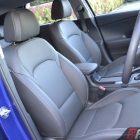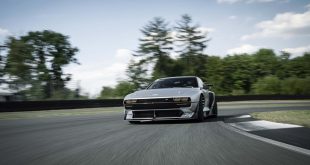The Hyundai i30 is one of the stars of the Korean brand’s extensive line-up. Now into its third-generation, the popular hatch has recently received an update for 2021.
Unlike some other brands, Hyundai’s mid-life updates are rather extensive and in the case of the i30, an entirely new front fascia. Featuring what the company calls ‘Sensuous Sportiness’, it is characterised by sharp lines and a reshaped front grille that is broader and lower.
The five-tier line-up has also been rejigged, with the base model now simply known as the i30 followed by the Active and Elite. The N Line and N Line Premium variants further cater to those looking for a slightly sportier drive.
The i30, Active and Elite are all powered by a 120kW/203Nm 2.0-litre naturally aspirated four-cylinder petrol engine, while the more powerful 150kW/265Nm 1.6-litre turbocharged four-cylinder petrol is confined to the N Line and N Line Premium. We’ll dive into the powertrain more closely below.
Prices start from $23,420 for the 6-speed manual i30 – the only manual transmission offered with the 2.0-litre engine. A 6-speed automatic adds $2,000 to the price tag. Forking out an extra $1,500 will nab you the $26,920 Active 6-speed automatic tested here.
Stepping up to the Elite is a $30,220 proposition, while the N Line and N Line Premium 6-speed manual start from $29,420 and $34,220, respectively, with the 7-speed DCT (double clutch transmission) asking an extra $2,000 for both variants.
What’s new?
Quite a lot actually.
As mentioned above, the 2021 Hyundai i30 hatch features a fresh new face sporting a reshaped front grille complimented by a pair of redesigned and sweptback headlights with black bezel.
The new ‘parametric pattern’ LED daytime running lights (DRL) sit prominently on the front bumper and also function as front indicator lights. This is slightly different to the European model’s V shaped DRL due to the fact that Australian delivered i30s are sourced from South Korea, instead of the company’s plant in the Czech Republic.
Around the back, the new rear bumper features repositioned rear reflectors paired with a mesh-effect full-width rear bumper insert for a wider and lower stance.
Fresh 16- (i30) and 17-inch alloy wheels complete the exterior makeover for the car.
Inside, the headline news is the upgraded infotainment screen measuring 8.0-inches in the i30, Active and N Line, and a sizeable 10.25-inches in the Elite and N Line Premium.
It comes with segment- and Hyundai Australia-first wireless Apple CarPlay and Android Auto smartphone connectivity, which not so long ago was confined to luxury marques costing two or three times more.
In keeping with the latest trend, part of the i30’s instruments have gone digital, too, in the form of a 7.0-inch TFT LCD screen. It features a digital speedometer display that changes according to the Drive Mode (auto only) selected.
Rear seat occupants also now get air-conditioning outlets mounted at the rear of the centre console.
On the safety front, the entire range now comes standard with Hyundai’s SmartSense suite of safety equipment, which includes Forward Collision-Avoidance Assist (FCA), or autonomous emergency braking in layman’s terms, with pedestrian and cyclist detection, Smart Cruise Control with Stop and Go (auto only), Lane Keeping Assist and Lane Following Assist with steering assistance, Driver Attention Warning and High Beam Assist.
Disappointingly, Blind-Spot Collision Warning and Rear Cross-Traffic Collision Warning are only available on the Elite variant, along with the Safe Exit Warning system which monitors the vehicle’s surrounding and sound an alert and warning display should an approaching vehicle is detected when opening the doors.
On the road
The venerable 2.0-litre naturally aspirated four-cylinder petrol engine’s 120kW at 6,200rpm and 203Nm at 4,300rpm isn’t earth-shattering in terms of output but provides the i30 Active with enough oomph to get through its daily chores effortlessly.
It’s connected to a smooth shifting six-speed torque converter automatic transmission that drives the front wheels. It does its job unobtrusively and generally dishes up the right gear at the right time. You can also take over manual control by tipping the gear lever towards you but there are no paddle-shifters to play with.
Take off is brisk off the mark and despite the modest outputs, the i30 Active never feels lacking in the performance department.
The engine does get a little vocal under hard acceleration but otherwise refinement is good with most road noise kept appropriately at bay.
There are three Drive Modes to choose from – Eco, Comfort and Sport – that alter the engine and transmission characteristics. Comfort is the best of both worlds and is the pick for everyday driving, while Sport is best left for more enthusiastic driving.
Thanks to its Australian tuned chassis, the i30 drives well on any road regardless of how fast or challenging with good body control and well-contained understeer. Its steering is also light and direct – perfect for city driving and easy parking.
Small bumps on the roads are dispatched away painlessly, while larger potholes are dealt with with minimal impact to the occupants.
Not all is nice and rosy, however, as on the driving assistant front, the i30’s adaptive cruise control can be overly reactive towards parked cars on the side of a narrow road and proceeds to jam the brakes unnecessarily as the computer thinks you are running into the back of the car in front.
It’s the same when going through a right hand curve on the freeway where it thinks the car in the inner lane as an obstacle and slows the car down, which could be rather dangerous when you’re doing 110km/h.
On the inside
Not much has changed on the inside except for the larger infotainment screen and digital instrument that give the i30 a more upmarket vibe. It’s a good thing because the sound ergonomics from the pre-facelift model are carried over.
The new infotainment system also heralds wireless Apple CarPlay and Android Auto smartphone connection to the i30 and it remains the only one in the segment to offer this thoughtful feature. You can wirelessly charge your phone, too.
It is however, not the most stable system as it kept losing its connection intermittently during our test, suggesting that more work needs to be done in the background to make it more user friendly.
It’s user-interface is also starting to show its age with grainy graphics which is no match with the newer system found on Hyundai/Kia’s new generation of displays. That’s nit picking though as it remains a simple and easy to use system.
The new 7.0-inch display in the instrument cluster is flanked by a physical rev counter and fuel and temperature gauge but it’s not as very configurable.
Rear seat occupants now get their own air-con vents but are still robbed of USB ports at the back.
Seat comfort is generally good front and back although there are no lumbar support for the front seats and the non-adjustable front centre armrest is a little short for my 5’7” frame to be fully supportive.
Flipping the armrest up will reveal a nice and deep bin which is also home to a single 12V outlet.
Further aback, the boot space is rated at 395L despite housing a full-sized spare wheel. It expands to a decent 1,301L with the rear seats tumbled.
Another welcome addition are the auto up/down power windows all round which adds to the premium feel.
Running costs
Hyundai says the i30 Active is rated at 7.4L/100km. Our weeklong test saw the trip computer returning 8.0L/100km of 80 per cent city commute, which is reasonable.
Like Hyundai’s wider range, the i30 comes with a five-year, unlimited-kilometre warranty, 1,500km complimentary first service and complimentary Roadside Assist for 12 months.
Servicing intervals are every 15,000km or 12 months, whichever comes first. Customers can pre-purchase the i30’s service for three ($783), four ($1,143) or five ($1,404) years, which are all rather reasonably priced.
Verdict
Design & Comfort
Performance & Handling
Quality
Economy
Equipment & Features
OUR SCORE
4.0/5
+ Plus
- Improved front styling with distinctive LED DRL
- More upmarket and ergonomic interior
- Comfortable ride and tidy handling
- Generous equipment
– Minus
- No blind-spot monitoring and rear cross-traffic alert
- Over sensitive adaptive cruise control
- Temperamental wiresless CarPlay
Overall
The updated 2021 Hyundai i30 hatch improves on what is already a decent package – comfortable, practical and good infotainment. The styling is not as blend as before and there are welcome improvement in the interior, too, in the form of a crisp digital instrument, wireless Apple CarPlay and Android Auto and all round auto up/down windows.
The i30 Active tested here is the sweet spot of the range with not much that is lacking. However, more work needs to be done to stabilise the connection on the otherwise excellent wireless CarPlay
2021 Hyundai i30 Hatch Pricing and Specification
| Price (Excl. on-road costs): | i30: From $23,420 i30 Active: From $26,920/As tested: $27,415 Tested option: Intense Blue Metallic Paint: $495 i30 Elite: From $30,220 i30 N Line: From $29,420 i30 N Line Premium: From $36,220 |
| Warranty: | 5 years/Unlimited kilometres |
| Warranty Customer Assistance: | 1 year Roadside |
| Country of Origin: | South Korea |
| Service Intervals: | 12 months / 10,000km |
| Engine: | 2.0-litre naturally aspirated inline four-cylinder petrol: 120kW @ 6,200rpm, 203Nm @ 4,700rpm 1.6-litre turbocharged inline four-cylinder petrol: 150kW @ 6,000rpm, 265Nm @ 1,500-4,500rpm |
| Transmission: | 6-speed manual/6-speed auto/7-speed dual clutch |
| Drivetrain: | Front-wheel drive |
| Power to Weight Ratio (W/kg): | i30 Active: 88.8 |
| Combined Fuel Consumption (L/100km): | i30 Active: Claimed: 7.4 / Tested: 8.0 |
| RON Rating: | 91 |
| Fuel Capacity (L): | 50 |
| Body: | 5-door hatchback, 5 seats |
| Safety: |
|
| Dimensions (L/W/H/W-B) mm: | 4,340/1,795/1,455/2,650 |
| Boot Space (min/max) (L): | 395/1,301 |
| Kerb Weight (kg): | i30 Active: 1,382 |
| Towing Capacity (kg): | Braked: 1,300kg / Unbraked: 600kg |
| Entertainment: | 7-inch colour touchscreen with Bluetooth, wireless Apple CarPlay and Android Auto, wireless smartphone charger, USB, Aux in, DAB+, 6 Speakers |
Competitors:
Toyota Corolla, Mazda3, Honda Civic, Kia Cerato, Volkswagen Golf, Ford Focus, Peugeot 308, Renault Megane, Suzuki Baleno
 ForceGT.com Car News, Car Reviews, Video Reviews, Tuning and much more.
ForceGT.com Car News, Car Reviews, Video Reviews, Tuning and much more. 




































